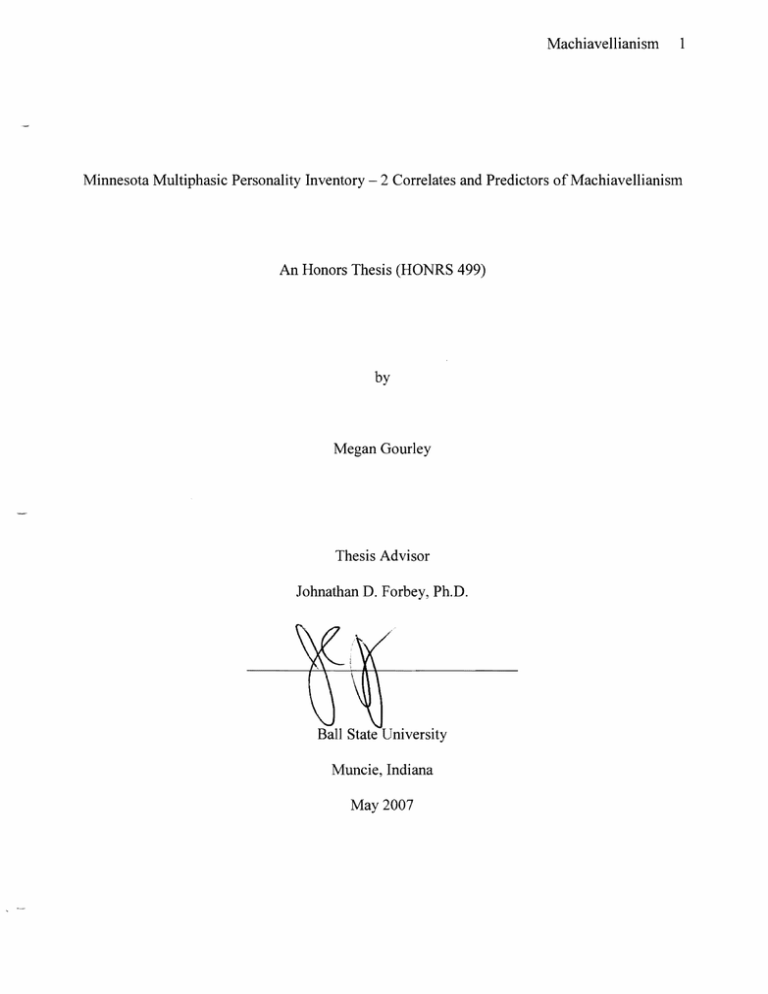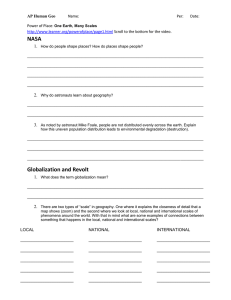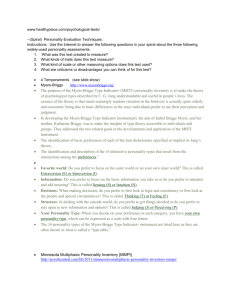Machiavellianism Minnesota Multiphasic Personality Inventory - 2 Correlates and Predictors of...
advertisement

Machiavellianism
Minnesota Multiphasic Personality Inventory - 2 Correlates and Predictors of Machiavellianism
An Honors Thesis (HONRS 499)
by
Megan Gourley
Thesis Advisor
lohnathan D. Forbey, Ph.D.
Ball State University
Muncie, Indiana
May 2007
Machiavellianism
2
Abstract
The current study investigated the ability of scales related to antisocial behavior on the
Minnesota Multiphasic Personality Inventory-2 (MMPI-2) to relate to and to predict scores on
the Machiavellianism Scale (MACH-IV). One hundred and seven participants, 51 men and 56
women, from a Midwestern university (ages 18 to 36, mean
19.5, SD
2.87) completed the
MMPI-2 and the MACH-IV, in addition to other measures, as part of a larger study. Relations
between MMPI-2 scales and scores on the MACH-IV were examined using zero-order
correlations. Significantly correlated scales were entered into an exploratory stepwise regression
analysis in order to determine the most parsimonious set of predictors of MACH-IV scores.
Results indicated Machiavellian traits as measured by the MACH-IV could be best accounted for
by MMPI-2 Content Scales ASP (Antisocial Practices) and ANG (Anger). These results suggest
people with high scores on the MACH-IV may be more likely to engage in anti-social behaviors
and have feelings of anger and hostility toward others.
Machiavellianism
3
Acknowledgments
I would very much like to thank Dr. Johnathan Forbey for taking on the job of being my
advisor. His willing advice and sense of humor have made the experience of writing this thesis
much easier and, surprisingly, even enjoyable. I would also like to thank Ms. Tayla Lee and Ms.
Nicole Blazek for all of their help with every aspect of this project. Without their astute editing
and sarcastic jibes, this study would have fallen apart.
Machiavellianism
4
Minnesota Multiphasic Personality Inventory - 2
Correlates and Predictors of Machiavellianism
In the area of personality and psychopathology testing, test validity is one of the chief
concerns and most important issues facing test administrators. The vast nUITlbers of personality
inventories and measures in existence enable practically any aspect of personality to be
measured, but it is important to establish that the test is measuring what it is purported to assess.
Currently, Dorfman and Leonard (2001) report that the most widely used personality inventory is
the Mimlesota Multiphasic Personality Inventory-2 (MMPI-2; Butcher et aI., 2001). The MMPI2 is a revised and updated version of the original MMPI, which was developed by Starke
Hathaway and J.C. McKinley in 1943, and is supported by an extensive research base (Dorfman
& Leonard, 2001). The MMPI-2 measures a variety of psychological, personality, social and
behavioral difficulties, and contains scales that also assess a test-taker's response style (e.g.,
over- or under-reporting symptomatology, random responding). Within the various constructs
assessed by this inventory are several scales devoted to measuring behaviors and attitudes
considered to be of an antisocial nature.
Despite the MMPI-2's widespread use, it is important to continue to validate and explore the
meaning of scale scores. One method of supporting the validity of a measure or scale is to
compare it with another established inventory. The Machiavellianism scale (Christie & Geis,
1970) is one such personality inventory. Drawing from the theories presented in Niccolo
Machiavelli's literary work The Prince, Christie & Geis designed the Machiavellianism (MACH)
scale to measure the level of manipulation an individual uses in order to control his or her
relationships with others. It is one of the most widely utilized measures on the use of
manipulative behavior in interpersonal relationships (Christie & Geis, 1970), which is often
Machiavellianism
5
considered to be part of a broader spectrum of antisocial behavior. This spectrum includes
psychopathy, which is described as remorselessly manipulative behavior, hidden beneath
superficial charm or guile (Glass & Newman, 2006).
In a study by Geis and Moon (1981), individuals with high and low MACH scale scores were
assessed on deceptive ability. Sixty-four male and female undergraduates, who had been
identified by the MACH scale as "low" or "high" in Machiavellian traits, were videotaped while
attenlpting to be deceptive, or "lie", about a fictional scenario. A second group of 64
undergraduates subsequently viewed the tapes and identified those from the first group of high
and low Mach participants as lying or telling the truth. The results revealed that judges were
more likely to believe the deceptiveness of those with high MACH scores than those with low
scores. Furthermore, it was demonstrated that individuals with high MACH scores were more
difficult for the judges to discriminate as truthful or deceptive than those with low scores (Geis &
Moon, 1981).
McHoskey, Worzel, and Szyarto (1998) investigated whether Machiavellianism (as assessed
by a revised version of the MACH, the MACH-IV) and psychopathy were similar enough to be
collapsed into one category based on a dimensional view of personality. Furthermore, the
authors nlade a distinction between primary and secondary psychopathy, with primary
psychopathy being characterized by antisocial behaviors motivated by the dispositions associated
with psychopathy (e.g., remorselessness, lack of empathy) and secondary psychopathy described
as similar to primary at the behavioral level, but differing in motivation (e.g., personality
disorder). For the study, 99 male and female undergraduate students completed questionnaires
on primary and secondary psychopathology and the MACH-IV. The authors found a positive
association between the MACH-IV and both primary and secondary psychopathy, leading
Machiavellianism
6
McHoskey et al. (1998), to suggest that the MACH-IV could be considered as a global measure
of psychopathy in non-institutionalized populations. However, while McHoskey et al. suggest
that MACH-IV scores could be a "global" measure of psychopathy, there are several components
to psychopathy (e.g., manipulativeness, callousness, lack of empathy, and antisocial behaviors, to
name a few), none of which separately would lead to labeling a person as a "psychopath", thus
suggesting that the Machiavellianisrrl Scale is still possibly viable as a separate measure of
manipulativeness, as it measures only one distinct component of psychopathy.
Prior to the development of the ~1MPI-2, selected scales of the MMPI (specifically Clinical
Scale 4 (Psychopathic Deviate, Pd)) have been the focus of a majority of the research literature
in the areas of antisocial behavior and psychopathy (Forgac & Michaels, 1982; Elion &
Megargee, 1975). In the above mentioned studies, findings include a significant association
between criminality and psychopathy as measured by the MMPI's Clinical Scale 4 (Pd) (Forgac
& Michaels,1982; Elion & Megargee, 1975). Since the MMPI-2 (an updated and re-normed
version of the MMPI) was introduced in 1989, there have been several scales that have been
added to the test that are also designed to assess for antisocial behaviors and attitudes, including
Content Scale Antisocial Practices (ASP), Personality Psychopathology-5 Scales Aggression
(AGGR) and Disconstraint (DISC), and Restructured Clinical Scale 4 (RC4).
The Content Scales were developed to help clarify elevations on the original MMPI scales by
focusing on more specific areas representative of problems (Dorfman & Leonard, 2001). The
construct validity of the ASP Content Scale and its differences from Clinical Scale 4 were
investigated in a series of studies reported by Lilienfeld (1996). Three separate studies were
conducted using undergraduate participants (N = 95, 110, and 100). ASP and Clinical Scale 4
(Pd) were administered to the participants, as well as several other corroborating personality
Machiavellianism
7
measures. In all three of the studies, A.SP was found to be moderately to highly correlated with
global indices of psychopathy as well as Antisocial Personality Disorder (as identified through
interviews, self-report, and observer ratings), and demonstrated discriminant validity from other
personality disorders (Lilienfeld, 1996). Furthermore, ASP was found to be significantly
correlated with the Psychopathic Personality Inventory (PPI) subscale Machiavellian
Egocentricity, as well as other psychopathic traits. In two of the three studies, ASP was found to
be more highly correlated with the htlachiavellian Egocentricity scale compared to Clinical Scale
4 (Pd).
The Personality Psychopathology - Five (PSY-5; Harkness, McNulty, & Ben-Porath, 1995)
constructs were developed fron1 analyses of personality disorders listed in the revised 3rd edition
of the Diagnostic and Statistical Manual of Mental Disorders (DSM-III-R; American
Psychological Association, 1987) and based on a dimensional model of personality
psychopathology. Two of the MMPI-2 PSY-5 scales, AGGR and DISC, are conceptually related
to antisocial behavior and psychopathic personality traits. The Aggressiveness (AGGR) scale is
a measure of exaggerated self-impoItance, dominant behavior, and physical aggression (Sellbom,
Ben-Porath, Lilienfeld, Patrick, & Graham, 2005). The Disconstraint (DISC) scale measures
impulsivity/control, harm avoidance, and moral traditionalism (Harkness, McNulty, & BenPorath, 1995). Recent studies have included the scales in studies of psychopathic personality
traits (Sellbom, Ben-Porath,
Lilienf~~ld,
Patrick, & Graham, 2005; Egger, De Mey, Derksen, &
van der Staak, 2003).
The recently developed MMPI-~~ Restructured (RC) scales (Tellegen et aI., 2003), which
were developed to increase the convergent and discriminant validity of the original MMPI-2
Clinical scales, may also be useful in measuring antisocial behavior. Sellbom and colleagues
Machiavellianism
8
(2005) include the RC and other MMPI-2 scales (i.e., Clinical, Content, and PSY -5) in a study of
psychopathic personality traits. The MMPI-2 was administered to a sample of college students
(N = 281) along with the Psychopathic Personality Inventory (PPI; Lilienfeld & Andrews, 1996).
The MMPI-2 RC4 and RC9 scales, along with 14 other MMPI-2 scales conceptually related to
the construct of psychopathy (Clinical Scales 2, 4, 7, and 9; RC Scales 2, 4,7, and 9; Content
Scales ASP and FRS, PSY -5 Scales .AGGR, DISC, INTR, and NEGE) were compared to total
scores on the PPI as well as its two factors (i.e., affective-interpersonal and social deviance).
The study found that the conceptually related MMPI-2 scales were related to scores on the PPI,
and that the RC scales (specifically, RC2, RC4, RC7, and RC9) produced the most parsimonious
assessment of psychopathic personality traits, with differing models depending upon which
aspect of psychopathy (as measured by the PPI) was being assessed (i.e., total score, en10tionalinterpersonal, or social deviance) .
The aforementioned studies all investigated the ability of various scales of the MMPI-2 to
assess the global construct of psychopathic personality traits and behaviors. The current study
examines an aspect of psychopathy 'which has yet to be specifically investigated with the MMPI2, in other words, the relationship b~!tween the construct of manipulativeness, as measured by the
MACH-IV, and conceptually related scales of the MMPI-2. Thus, the objective of the current
study is to determine the ability of the selected MMPI-2 scales to relate to and to predict scores
on the MACH-IV.
Method
Participants
Participants in the current study included 107 undergraduate students, 51 men and 56
women, ages 18 to 36 (mean=19.5,' SD= 2.869), enrolled in an introductory psychology course at
Machiavellianism
9
a mediun1-sized Midwestern university. From the original sample, 99 (92.5%) participants
identified themselves as Caucasian, four (3.70/0) as African American, and four (3.7%) identified
as "other" or did not specify an ethnicity.
Five participants were eliminated from the study due to producing invalid MMP-2 test
results. The following criteria (recolbmended by the test authors) were used to identify and
remove invalid MMPI-2 test results: T Score> 80 on TRIN, VRIN or L; T Score> 100 on F,
FB, or Fp; and/or K > 80. There were no invalid MACH-IV profiles (defined here as not
responding to 100/0 or more of the items).
There was no difference on gender between groups; however, there were significant
differences between valid and invalid groups in terms of age and ethnicity. The mean age of
participants who produced invalid profiles was significantly older than those of valid profiles
-2.368, P < .02). Ethnically speaking, African Americans and those who identified as
(t(105)
other or did not identify their ethnicity were more likely to produce invalid profiles than
Caucasians participants, X2 (2,N = 102) = 8.020, p < .05. However, this difference is most likely
a result of the relatively low numbers of ethnic minorities participating in the study, which would
cause any differences to become stqtistically significant, while not necessarily being clinically
meaningful.
Of the remaining 102 participants, 49 were male and 53 were female, ages 18 to 36 years
(M
19.5, SD
2.87. Ethnically speaking, 96 (94.2%) identified as Caucasian, three (2.9%) as
African American (2.9%), and three (2.9%) either reported as Other or did not identify their
ethnicity.
Machiavellianisn1
10
Measures
MMPI-2. The MMPI-2
con~ists
of 567 True and False items designed to assess a broad
range of patterns in personality and psychological functioning. There are also several scales
included to measure cooperation, aIid test-taking attitude. We examined 10 of the MMPI-2
scales conceptually related to anti-sbcial behaviors and practices in order to determine the ability
of those scales to relate to and to predict scores on the MACH-IV. A list of the MMPI-2 scales
included in the current study can be: found in Table 1. For further information regarding the
psychometric characteristics of thes~~ scales, the MMPI-2 manual (Butcher et aI., 2001) and RC
scale monograph (Tellegen et aI., 2~03) are excellent sources, providing internal consistencies,
test-retest reliabilities, and other relevant statistical information.
MACH-IV. The Machiavellia.nism IV scale (MACH-IV; Christie & Geis, 1970) is
intended to measure of manipulatiop employed in interpersonal relationships, including
interpersonal tactics, views of human nature, and abstract or generalized morality. It consists of
20 items that are rated on a 6-pointLikert scale ranging from -3 ("Disagree Strongly") to +3
("Agree Strongly").
Procedure
Computerized versions oftij.'e MMPI-2 and the MACH-IV were completed by
participants (as part of a larger study) in a single testing session. The administration of the
MMPI-2 and MACH-IV (as well as other criterion measures) was counterbalanced across
participants to control for order effects. Scripted oral instructions were read to the participants,
I
i
including a statement that they wer~: free to discontinue at any time without repercussions and to
only answer questions which they {dt comfortable answering. Participants were also assured of
Machiavellianism
11
complete anonymity. Each student received an informed consent form before completing the
measures and received course credi~ in exchange for participation.
Results
Zero-order correlations werJ examined between the conceptually related MMPI-2 scales
and the MACH-IV total score.
Alp~a
level was adjusted utilizing a Bonferroni correction to .005
(.05 divided by 10) to reduce the po'ssibility of a Type I error. Correlations between the MMPI-2
I
scales and MACH-IV total scores at,e reported in Table 1. Eight of the 10 selected MMPI-2
scales exhibited significant correlations after the Bonferroni correction with the MACH-IV total
score, specifically, Scale 9, ANG, OYN, ASP, DISC, RC3, RC4, and RC9.
Because so many of the sel~cted scales were found to correlate significantly with the
MACH-IV total score, a stepwise s~atistical regression was performed to determine which scales
I
on the MMPI-2 would be most use{ul in predicting MACH-IV scores. Of those included, only
two MMPI-2 scales were found to ~e statistically significant. The content scales ASP and ANG
were found to account for 39.90/0 o{the variance in MACH-IV total scores (F(2, 99) = 32.86,p:S
.001).
Discussion
The goal of the current stud~' was to explore the ability of scales related to antisocial
behavior on the MMPI-2 to relate
t~, and to predict scores MACH-IV, a measure of interpersonal
manipulation. The results of the cdlTelational statistics for MMPI-2 scales and MACH-IV scores
are very promising. Several of the iscales conceptually related to antisocial behaviors on the
MMPI-2 were significantly related:to total scores on the MACH-IV. This finding suggests that
I
the MMPI-2 scales under investigahon were picking up on antisocial traits, as measured by the
MACH-IV scales, as was
hypothes~zed.
The results of the regression analysis statistics results
Machiavellianism
12
were able to narrow down the MMBI-2 scales accounting for MACH-IV scores most effectively
to ASP and ANG. This suggests that people with Machiavellian traits may be more likely to
engage in anti-social behaviors and rtave feelings of anger and hostility toward others.
Unlike the inlplication ofth~ McHoskey, et al. (1998) study-that the MACH-IV could
be considered as a global measure o~~ psychopathy-the current study suggests an alternative
implication of the MACH-IV by extending upon the results of the Sellbom et al. (2005) study
discussed earlier. In the Sellbom etlal. (2005) study, psychopathic behavior and traits as
i
measured by the PPI were best predicted by selected RC scales (i.e., RC2, RC4, RC7 and RC9).
i
Furthermore, in the Sellbom et al. (~005) study, the predictive models varied slightly, depending
upon which aspect of psychopathy ~lere being explored (Le., the total PPI score or the PPI
I
factors affective-interpersonal facto~ and social deviance).
Interestingly, the social dev~ance factor of the PPI contains a Machiavellian component
I
(similar to that assessed by the MAtH-IV), but also additional components related to
impUlsivity, non-planning, and blatV.e externalization. Thus, Sellbom et al. 's (2005) predictive
model contained MMPI-2 scales related to several of these constructs (i.e., RC2, RC4 and RC9).
Comparatively speaking, the prese4t study assessed only the Machiavellian aspect of this scale,
and found a somewhat different setofpredictors (i.e., ASP and ANG). While the present study'S
predictor set is conceptually simila~ to that found by Sellbom et al.'s (2005) for social deviance,
I
I
each set of scales have unique (as well as shared meanings), suggesting that Machiavellianism is
I
a unique component of psychopatht, unlike the conclusion reached by McHoskey et al. (1998)
(i.e., that Machiavellianism and psyehopathy are equivocal). This suggests that the MACH-IV
Scale is useful as a separate
construct of psychopathy.
meas~e of manipulativeness, but is still related to the larger
Machiavellianisn1
13
The limitations of the curren~ study included small sample size and limited diversity in
the sample. With only 102 particip~lts in the final sample, generalizability of the results is
!
diminished. Furthermore, the lack df minority participation in the current study produces further
limitations on the results ability to 1Ply to individuals of differing racial/ethnic background
from the included participants. As! result of so few minorities taking part in the current study
(N = 6), a greater likelihood of min<j>rities producing invalid profiles was found simply because a
i
single invalid profile in such a small sample could greatly skew the resulting statistics. Finally,
the fact that participants in this studpr were recruited solely from a college popUlation also limits
I
the generalizability of the results to Ithe population at large, as well as the fact the only one
measure of Machiavellianism was 4tilized in the current study. Further research on the ability of
i
the MMPI-2 to relate to and predictl :Machiavellianistic traits would benefit from using additional
measures in larger samples,
includi~g
more diverse populations, as well as forensic samples,
I
where such characteristics are
mor~ prevalent.
i
Based upon the results ofth~:s study, the MMPI-2 ASP and ANG were highly effective at
I
I
predicting scores on the
MACH-IV~
accounting for nearly 40% of the variance in MACH-IV
scores. Overall, scales related to aqtisocial practices on the MMPI-2 were significantly related to
I
Machiavellianism. Therefore, it aPf,ears that the MMPI-2, and specifically the ASP and ANG
scales, is able to relate to and predi¢t scores on a measure of Machiavellianistic traits and
I
I
characteristics (i.e, the MACH-IV).I However, further research is necessary to expand upon the
findings of the current study.
Machiavellianism
14
References
American Psychiatric Association. (11987). Diagnostic and statistical manual of mental disorders
I
(3 rd ed., rev.). Washington, DC: Author.
Butcher, J. N., Graham, J. R., Ben-Rorath, Y. S., Tellegen, A., Dahlstrom,W.G., & Kaemmer, B.
I
(2001). Minnesota Multiphaiic Personality Inventory-2: Manualfor administration and
scoring (2nd ed.). Minneapoji.s: University of Minnesota Press.
I
Christie, R., & Geis, F .L. (1970). Studies in Machiavellianism. New York: Academic Press.
Dorfman, W.K., & Leonard, S. (20d 1). The Minnesota Multiphasic Personality Inventory-2
(MMPI-2). In Dorfman, W.I/:, & Hersen, M. (Eds.), Understanding Psychological
Assessment (145-171). New iVork: Kluwer Academic/Plenum Publishers.
Egger, lI.M., De Mey, H.R.A.,
I
De~ksen,
JJ.L., & van der Staak, C.P.F. (2003). Cross-cultural
replication of the five-factor[lnodel and comparison of the NEO-PI-R and MMPI-2 PSY5 scales in a Dutch psychiat~ic sample. Psychological Assessment, 15( 1), 81-88.
I
Elion, V.H. & Megargee, E.I. (197~). Validity of the MMPI Pd scale among black males.
Journal of Consulting and JUnical Psychology, 43(2), 166-172.
Forgac, G .E. & Michaels, EJ.
(198~~). Personality characteristics of two types of male
exhibitionists. Journal ofA~normal Psychology, 91(4),287-293.
I
Geis, F.L., & Moon, T.H. (1981). :N1:achiavellianism and deception. Journal ofPersonality and
I
I
Social Psychology, 41(4), 7~6-775.
Glass, S. P., & Newman, J. P.
(200~). Recognition of facial affect in psychopathic offenders.
Journal ofAbnormal Psycho/logy, 115(4), 815-820.
Harkness, A.R. (1992).
Fundament~ll
topics in the personality disorders: Candidate trait
i
I
dimensions from lower regi~ns of the hierarchy. Psychological Assessment, 4,251-259.
Machiavellianism
15
Harkness, A. R. & McNulty, lL. (1 ~94). The personality psychopathology five (PSY -5): Issue
from the pages of a diagnostic: manual instead of a dictionary. In S. Strack & M. Lorr
I
(Eds.), Differentiating norm~l and abnormal personality. New York: Springer.
Harkness, A. R., McNulty, lL., & Bien-Porath, Y.S. (1995). The personality psychopathology
I
five (PSY-5): Constructs and MMPI-2 scales. Psychological Assessment, 7(1), 104-114.
I
Lilienfeld, S.O. (1996). The MMPI-~~ antisocial practices content scale: Construct validity and
comparison with the psychopathic deviate scale. Psychological Assessment, 8(3), 281293.
Lilienfeld, S.O. & Andrews, B.P. (l1996). Development and preliminary validation of a self
I
I
report measure of psychopathic personality traits in noncriminal populations. Journal of
I
Personality Assessment, 66, ~.88-524.
McHoskey, lW., Worzel, W. & Szrarto, C. (1998). Machiavellianism and psychopathy.
Journal ofPersonality and
Sellbom, M., Ben-Porath, Y.S.,
~ocial Psychology, 74(1), 192-210.
Lili~:nfeld,
S.O., Patrick, C.J., & Graham, l.R. (2005). Assessing
i
psychopathic personality traits with the MMPI-2. Journal of Personality Assessment,
85(3), 334-343.
I
Tellegen, A. (1982). Brief manual,r the Differential Personality Questionnaire. Unpublished
manuscript, University of~innesota, Minneapolis. [Since renamed Multidimensional
Personality Questionnaire]. I
i
Tellegen, A., Ben-Porath, Y. S., MtNulty, l L., Arbisi, P. A., Graham, l R., & Kaemmer, B.
(2003). MMPI-2
interpretation.
I
Restructur~'d Clinical
Minneapolis~
(RC) scales: Development, validation, and
University of Minnesota Press.
Machiavellianism
Table 1
I
Correlations Between MMPI-2 Scal~:s and MACH-IV Total Scores
MACH-IV
MMPI-2 Scales
Total
I
I
Clinical Scales
I
.282
4 (Pd, Psychopathic D :viate)
.346*
9 (MA, Mania)
Content Scales
I
ANG (Anger)
.485*
.508*
CYN (Cynicism)
ASP (Antisocial Pracfces)
.589*
Personality Psychopathology Five ( PSY-5)
DISC (Disconstraint)
.385*
AGGR (Aggressiveness)
.308
Restructured Clinical Scales
I
.528*
RC3 (CYN, Cynicism
.359*
RC4 (ASB, Antisocial Behaviors)
.525*
RC9 (HPM, Hypomal111a)
Note: * p < .005
i
I
I
!
I
i
16
Machiavellianism
Table 2
Regression Analysis Results for M~PI-2 Scales
I
I
I
MMPI-2 Scale
Antisocial Practices (ASP)
RI
R2
R2adi
.58~~
.347
.340
I
.387
1
I
Antisocial Practices (ASP),
Anger (ANG)
l
.63G~
I
I
.399
I
F
53.136
32 .864
F Test
df
1, 100
2,99
p< :
.005
.005
17



